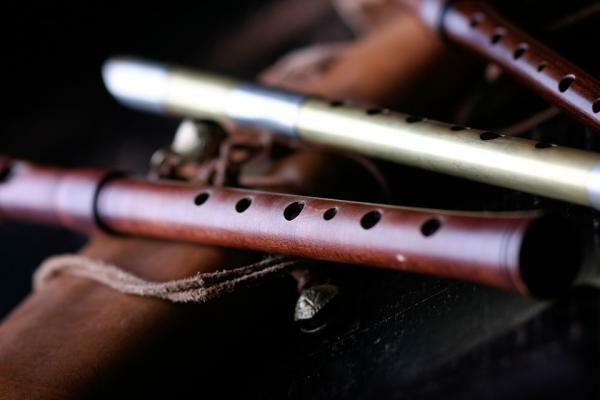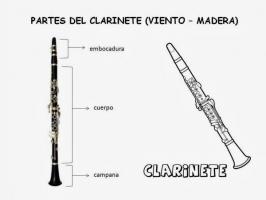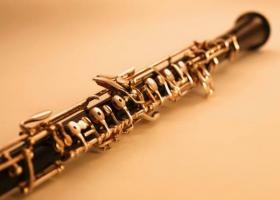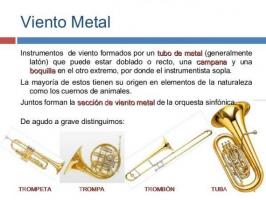Complete LIST with WIND musical INSTRUMENTS

The world of musical instruments it is a wide field to explore and have fun. They come in all sizes, shapes, materials, personalities, qualities, and of course sounds. Thanks to all these variations there is at least one instrument that suits the curiosity of anyone who is interested in music and the ability to have fun with sound.
There is a type of instrument whose principle is one of our most basic physical characteristics: breathing. In this article by a TEACHER we will talk about the wind instruments, what they are, what they are and their characteristics.
Index
- What are wind instruments
- List of woodwind instruments
- Brass instruments
- Other less common wind instruments
What are wind instruments.
The classification of instruments in music it is done by the technique we use to produce sound. Wind instruments, as their name already indicates, use air flow passing through a defined space to create musical notes of different tunings.
We know that the wind itself does not have a sound, it is its movement and its interaction with objects that allow us to hear it, such as when a very strong blizzard passes through a narrow street or when it enters through the window creating a noise acute. Everything happens
due to the effect of cutting or air vibration.We also call these instruments "aerophones".
List of woodwind instruments.
Any instrument that use the wind to make sound belongs to this category, such as the organ and the bagpipes. However, wind instruments are mostly those that work with the breath, the utilizing human lung capacity to blow through the mouth and into the instrument in question.
Wind instruments can be used in many styles and genres of music, including genres folkloric, funk and Latin groups, jazz and above all, in classical music as part of the orchestra symphonic. Within these instruments there are two main categories: woodwind and metalwind.
Woodwind instruments
These instruments bear this name because, although today various materials are used for their manufacture, traditionally they were made with wood.
Woodwind instruments sare generally cylindrical, of different diameters and lengths depending on the desired tessitura. Many are made up of several parts that must be assembled before playing and disassembled again for storage. They have holes that can be covered or uncovered with the fingers (both directly and through mechanisms, depending on the instrument) to change the notes and Some require a specific piece such as the reed or the reed, which is the one that comes into contact with the mouth and is the main responsible for creating the vibration.
These are the most common woodwind instruments:
- Recorder: Commonly made of plastic, it is the most widely used instrument for school education thanks to its low cost and accessibility. There are them of different tunings (soprano, alto, tenor, etc.) and it works based on bezel, which is a type of cut in one of the holes of the instrument responsible for the vibration. It is played vertically with both hands and the fingers cover its holes directly.
- Transverse flute: It is played horizontally, with both hands and works with bezel. It is made of metal and the holes are covered and uncovered by means of mechanisms with keys. Its sound is sweet and it can be very agile.
- Picolo or piccolo: It has a sound similar to the transverse flute but has a higher tessitura and is smaller. It is made with a wooden body and metal parts. It is played vertically with both hands and through mechanisms with keys.
- Oboe: Currently manufactured with a wooden body and metal parts. It works with tongue. It has a nasal ringing sound. It is played vertically with both hands, through mechanisms with keys.
- Clarinet: It is also played vertically, with both hands and key mechanisms. It works with simple reed. Made with wood and metal parts. Another common form of the clarinet is the bass clarinet, which has a more serious tessitura.
- Bassoon: It is the instrument with the lowest tessitura of these instruments. It is made of wood and metal parts and measures approximately 1 meter and a half. Has double reedIt is also played vertically, with both hands and key mechanisms. Within the same family there are bassoon and counter-bassoon, which have different tessitura.
- Saxophone: Despite being made mostly of metal, it is included in this category since the party in charge of sound production "the grey hair", it is made of wood. It has more keys than the rest of the brass instruments that we have mentioned. It works with a plastic mouthpiece, which is where the cane (a type of reed). It is played with both hands and is held with a string or piece around the neck of the musician. It has a warm timbre and good dynamic range of sound. In the saxophone tessitura family we find the soprano, alto, tenor and bass saxophone. Due to popularity, it is frequently used in genres such as jazz.

Brass instruments.
Unlike the other category, they are made of metal (mostly brass). Thanks to this and its qualities, its sound is much more powerful and / or extravagant. Some work with keys and others with pistons. Some have very few of these, this is because they work by means of harmonics, changing the air pressure to increase or decrease the range of the tessitura.
In general, they have a single long body that combines straight directions and bends and ends in a campaign, which amplifies the sound as it exits the instrument. The vibration is carried out mainly with the lips in contact with a metallic piece called nozzle, which can be substituted to change the timbre of the sound. Optionally, tools can be placed on the hood called mutes, to alter the sound. Most use one hand to hold the instrument and the other to press the keys or pistons. These are the most common brass instruments:
- Trumpet: It has only 3 pistons. It has the ability to create very sharp and powerful sounds that are used in genres such as Latin music. There are trumpets of different tunings.
- Cornet and flugelhorn: They are similar in shape and size to the trumpet. They change mainly in timbre and tessitura.
- French horn or horn: Its body is spiral-shaped, it has keys instead of pistons. Thanks to its sweet sound, it is sometimes combined in musical formations with woodwind instruments. Unlike the trumpet, the horn is not as agile and precise in terms of the velocity of the notes.
- Trombone: It is long-bodied and does not have keys or pistons, unlike most wind instruments. In his case, he has a piece that slides, moving away or approaching the musician to change notes. Within the same family there are different tones and tessitura, such as bass trombone, which is more serious.
- Euphonium or euphonium: It is used less frequently than the rest of these instruments. It is played with the bell facing up and its appearance is often compared to a tuba, but smaller in size. Works with nozzle and pistons.
- Tuba: It is the instrument with the lowest tessitura, generally in charge of the basses in the family of instruments of brass, the equivalent of the double bass on string instruments and the bassoon on wind instruments wood. It works with nozzle and pistons and is large in size.
- Helicon and sousaphone: They are variations of the tuba, which change shape and some characteristics to be used in other circumstances such as marching bands.

Other less common wind instruments.
There are many more wind instruments, some we have already mentioned, such as the organ and the bagpipe, and then others that we use less frequently such as the harmonica and ocarina.
Let us remember that there are also wind instruments of non-Western origins, such as the pan flute, the sakuhachi, the Tibetan horn, erke, muceño, etc.
There is a wide variety offering many opportunities for creativity with sound. Now that you know more about these instruments you may be interested in taking one closer to better understand what you have learned.
If you want to read more articles similar to Wind instruments, we recommend that you enter our category of Musical instruments.



